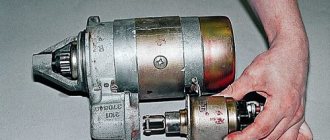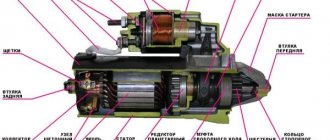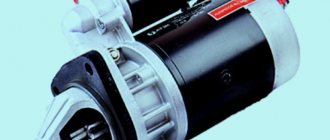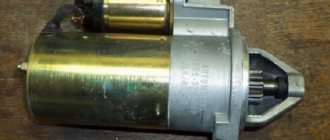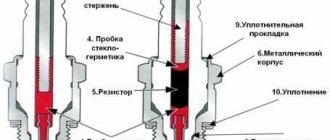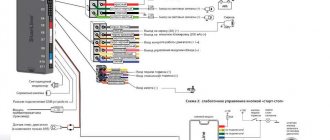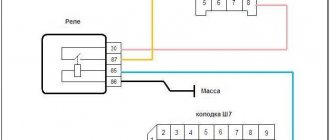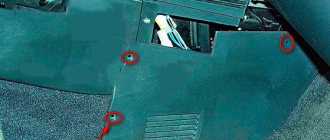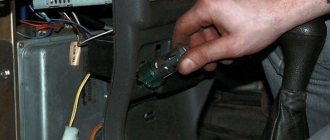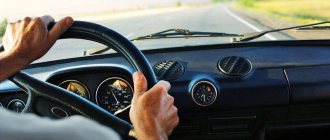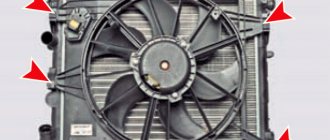A car is often included in the list of the most necessary items for a comfortable life, and the inability to use it is perceived by many as a serious deprivation. However, all equipment breaks down sooner or later, and a car, for example, may stop starting. Here, the first thing that is required is to find the cause and fix the problem as quickly as possible. The trouble is that owners often have no idea where to start the work. In this article we will tell you why the Priora specifically does not start and why its starter does not turn.
Why doesn't the starter work?
A car starter is an electric motor that is powered by a battery and is designed to start a gasoline or diesel engine. For this reason, this device is prone to both mechanical failures and problems in electrical power circuits or problems in the contact area.
- determine the full charge of the battery;
- carry out diagnostics of the ignition switch contact group;
- check the traction relay (retractor)
- check the performance of the bendix and the starter itself;
The ignition switch contact group can be checked very quickly. To do this, just insert the key and turn on the ignition. The lighting of the lights on the dashboard will clearly indicate that the contact group is in working condition, that is, you should look for problems in the ignition switch only if the indicated lights on the dashboard do not light up after turning the key.
In the case of a suspected battery, it will be enough to turn on the headlights or headlights, and then evaluate the lighting of the light bulbs on the dashboard, etc. If these energy consumers light up very dimly or do not turn on at all, then there is a high probability of a deep discharge of the battery. You should also check the battery terminals and the ground connection to the body or engine.
Special attention should be paid to the “negative” wire, which comes from the battery and is attached to the car body. A common problem is that
ground contact may disappear
not constantly, but with a certain frequency. To eliminate it, it is recommended to disconnect the ground at the point of attachment to the body, clean the contact well, and then try to start the engine again.
To check the battery on a car with your own hands, you need to remove the negative terminal, after which the voltage at the battery outputs is measured with a multimeter. A reading below 9V will mean that the battery is low and needs to be charged.
The presence of characteristic clicks from the starter when trying to start the engine, which are also accompanied by a noticeable decrease in brightness or complete extinction of the lights on the dashboard, indicates that the solenoid relay is clicking. The specified relay can click both in the case of a discharged battery, and as a result of malfunctions of the retractor or starter itself.
We also recommend reading the article about
Why does the starter click but not turn over the engine?
. From this article you will learn about possible malfunctions that cause the traction relay to click instead of starting the engine, as well as how to check the car starter yourself.
Causes and solutions
If the car does not start because the starter does not turn, but makes characteristic clicks, there may be several reasons for this:
- The power wire connecting the relay winding and the starter has burned out.
- The brushes and bushings are out of order.
- The armature is shorted on the winding.
- The winding has broken.
- The fork on the drive is deformed or destroyed.
The cause may also be insufficient battery charge. In some cases, to eliminate this problem, it is enough to charge the battery and try to start the car again. The cause may be jamming of the motor shaft and bushing. It is possible that the rotor caught the “plus” of the stator. It is also possible that the winding is shorting.
Even if the problem is easily and quickly solved, one glance will not be enough to detect it. To understand the reason, you first need to let the car cool down (this requirement is especially important in hot weather).
You will have to remove the clicking starter.
If the problem is with the shaft, it needs to be tightened. It may have malfunctioned. Then the shaft will need to be replaced, after which the starter will continue to function normally. If the bushings are deformed, they will need to be replaced. This happens extremely rarely, so in most cases you will not have to replace the bushing to fix the problem. If the rotor rubs against the stator, the shaft must be aligned. You can determine whether a wire has burned out by the appearance of black spots and a characteristic odor.
Bendix and retractor
The above symptoms will indicate that the fault is localized to the solenoid relay or the bendix does not engage the flywheel. Note that in the case of Bendix, a more characteristic sign is that the starter crunches and does not turn the engine. Another common sign of a bad starter is that the starter buzzes but does not turn the engine.
To check the traction relay, voltage must be supplied from the battery to the power terminal of the relay. If the engine starts to turn over, then the retractor starter is obviously faulty. A frequent breakdown is the burning of the contacts. To eliminate it, you will need to remove the relay to clean the nickels.
After cleaning, you must still be prepared to quickly replace the traction relay, since in the factory the contact pads are covered with special protection that resists burning during operation. Stripping will mean that the specified layer is removed, as a result of which it is difficult to predict the moment when the retractor coins will burn again.
Now let's turn our attention to the starter bendix. Bendix is a gear through which torque from the starter motor is transmitted to the flywheel. The Bendix is mounted on a single shaft with the starter rotor. To better understand, it is necessary to understand how a starter works. The principle of operation is that after turning the ignition key to the “start” position, current is supplied to the solenoid relay.
After the engine starts (the crankshaft begins to rotate on its own) with a working starter, the key in the ignition switch is thrown back, and electric current no longer flows to the traction relay. The lack of voltage causes the retractor to disengage the bendix from the flywheel, as a result of which the starter stops spinning.
New Lada: Lada Priora standard equipment (photos, features and options) » Lada.Online - all the most interesting and useful about LADA cars
Wear of the Bendix gear means that there is no normal connection with the flywheel ring. For this reason, a cracking sound may be heard when starting the engine, and the starter may spin freely without engaging and buzzing. A similar situation arises if the teeth of the flywheel rim are heavily worn.
The repair involves disassembling the starter to replace the bendix and/or removing the transmission to replace the flywheel. To check the bendix yourself, you will need to close two power contacts on the traction relay. The electric current will bypass the relay, which will determine the rotation of the starter. If the starter rotates easily and hums, you should check the quality of engagement of the bendix with the flywheel.
Video “Dismantling, disassembling and assembling the starter”
Detailed instructions for dismantling the mechanism at home, disassembling it, repairing it and assembling it are given in the video below (the author of the video is Sergey Tsapyuk).
Now many Russians cannot imagine life without a car. Therefore, it is easy to understand them when the vehicle suddenly stops starting at one, far from perfect moment. This is even more unpleasant if it happens in the morning before leaving for work.
At the same time, many car enthusiasts are lost in such a situation and have absolutely no idea how to fix the breakdown on their own.
This material will tell you why a car like Priora may not start in cold weather, and why its starter does not turn. It is important to note that in most cases the problem can be easily fixed on the spot, and if you know how to do this, you can save a lot of money on a car service.
Starter bushings
A frequent breakdown is also the malfunction of the starter bushings. The starter bushings (starter bearings) are located at the front and rear of the unit. These bearings are necessary to rotate the starter shaft. As a result of wear on the starter shaft bearings, the traction relay clicks, but the starter does not spin itself and does not crank the engine. This malfunction is as follows:
- the starter shaft is not in the correct axial position;
- the primary and secondary windings also close;
This situation can lead to windings burning out and power wires melting. Sometimes a short circuit occurs in the vehicle's electrical circuits, which causes a fire. In the case when the starter clicks but does not spin itself, you cannot hold the key in the “start” position for a long time. It is recommended to make several short attempts to start, as there is a chance that the shaft will be able to return to its place.
Please note that even after a successful start of the internal combustion engine, the starter will require mandatory and immediate repairs to replace the bearings. Remember, jamming of the starter shaft can lead to a short circuit and fire. We also add that a starter with problem bushings can work absolutely properly when cold, but refuse to turn when hot.
If the starter does not turn over when hot or turns the engine poorly after warming up, then you need to:
- Check the battery, battery terminals and power contacts. If the battery is in good condition and was 100% charged before the trip, but then discharged, then you should check the alternator regulator relay, alternator belt, tension roller and the alternator itself. This will prevent battery discharge and subsequent undercharging while driving;
- then you should pay attention to the ignition system and fuel supply system, check the spark plugs. The absence of comments on the operation of these systems, which is accompanied by the fact that the starter turns poorly when the battery is charged, will indicate a malfunction of the starter.
We also recommend reading the article about
how to properly charge a car battery with a charger
. In this article, you will learn about the basic requirements and recommendations for properly charging the battery, as well as how to charge the battery without a charger.
Please note that the device gets very hot together with the engine in the engine compartment. Heating of the starter leads to thermal expansion of certain elements inside the device. After repairing the starter and replacing the bushings, the indicated expansion occurs with the starter bearings. An error in selecting the required bushing sizes can lead to jamming of the shaft, as a result of which the starter does not spin or spins very sluggishly on a warm engine.
Mechanical and electrical problems
The engine starter may not work due to wear out of the bearings located at the front and rear of the engine. Their function is to ensure smooth acceleration of the starter shaft. If they are worn out, the retractor will make clicks, and the crankshaft of the power unit will remain motionless. The reasons for this problem are:
- imbalance of the starter shaft;
- burning or short circuit of winding turns.
Note that this may cause a short circuit in the vehicle's electrical circuit, which may cause a fire. If the starter does not respond to turning the ignition key, you cannot force it to work for a long time. It is best to make several short starts of the engine.
Since the design of the vehicle’s power unit starting device is based on an electric motor, the voltage necessary to increase the speed of its shaft is supplied to the winding through graphite brushes. The material they are made of does not have sufficient strength, these elements wear out quickly.
Other reasons why the starter may not respond when the ignition is turned on
In some cases, there have been malfunctions in the operation of automobile anti-theft systems (car alarms, immobilizers). Such systems simply block the supply of electric current to the starter after the security mode is removed. At the same time, the diagnostics shows the full functionality of the battery, power contacts and other elements of electrical equipment that are involved when starting the engine from the starter.
New Lada: Lada Priora relay and fuse diagram
The next item to check is the solenoid relay. If it breaks, the starter can:
- be completely silent, that is, do not make any sounds after turning the key to the “start” position;
- hum and crank, but do not turn the engine;
- click repeatedly or once without cranking the crankshaft;
Car starter malfunction. The most common causes of a poorly functioning starter
A starter is an electromechanical device that starts the engine by creating primary torque of the crankshaft at the required speed to create a compression ratio to ignite the combustible mixture.
And when the starter does not work or works intermittently, starting the engine is very problematic and sometimes impossible. But before you start looking for the reasons why the starter does not turn, you need to remember that this unit works in tandem with other vehicle systems in a common starting-charging circuit (battery-start control mechanism-starter). Therefore, there can be both mechanical and electrical breakdowns, which have their own distinctive features.
Electrical causes of failure
When the starter does not turn the engine or turns it slowly, with insufficient power to start, then first of all it is worth checking the electrical circuit, starting from the battery:
If the Priora does not want to start
When the car does not start and its starter, accordingly, does not turn, then most likely the culprit is the battery. This is indicated by the following additional symptoms:
- the solenoid relay clicks;
- The instrument lights on the panel go out.
The easiest way to test the battery is to turn on the headlights. If they burn weakly, you will have to charge the battery.
When the battery appears to be in good condition, but the car still does not start, feel the cables connected to it. If the ends screwed to the terminals (or the starter itself) are warm, then there is poor contact or oxidation. All this creates increased resistance, stealing battery power.
Here:
- unscrew the wires;
- clean the battery leads and terminals themselves;
- return the cables to their place;
- Make sure that the ground on the body and the positive on the starter are securely fastened.
Next, check if there is voltage at the ignition switch. This is done like this:
- disconnect the connector of the cable going from it to the traction relay;
- turn the key to the engine start position;
- measure the voltage at the connector.
Scheme, theory and practice
Let's see what the wiring diagram of any electric starter looks like. Contact B is constantly supplied with voltage.
Starter and its external circuits
In the diagram we see three “positive” contacts and one negative (8), which is always connected to the body. What needs to be closed:
- Before closing the starter, locate the S terminal. It is often made in the form of a petal;
- How to distinguish contacts B and M: the first will have a potential of “+12”;
- You need to close contact B with terminal S. This is done briefly and after turning on the “neutral”;
- Contacts M and B cannot be closed.
We move from theory to practice. On a VAZ-2114 car everything looks simple.
Solenoid relay VAZ-2114
Terminal B here is covered with a rubber band, and petal S is in contact with the terminal in plastic. The plastic plug is removed before “shorting”.
Closing the starter contact with a screwdriver
Make sure that the metal of the screwdriver does not touch the relay body when closing. Otherwise, we will simply close the “+” contact to “ground” (dangerous). All work is carried out with the ignition on.
- B – Bold, “thick” wire;
- M – Motor (electric motor);
- S – Start.
How to remove the electric starter
The procedure in this case is as follows:
- remove the terminals from the battery;
- the “plus” connector is removed from the starter;
- removed from the relay block;
- The nuts securing the faulty unit are unscrewed.
Then you can safely remove it.
Next you will need to check the functionality of the relay. To do this, take emergency wires to start from another car. The negative one is installed on the battery and on the starter housing. “Plus” is connected to the relay. The latter in this case (if it works properly) is triggered and moves the gear. The absence of this reaction indicates a breakdown of this element.
Lada won't start when cold
Check how fast the crankshaft spins on your Priora. Too low a speed indicates:
- dead battery;
- hardening of the lubricant.
The absence of any reaction from the motor suggests that the problem lies in:
- fuel system - sometimes condensate freezes there;
- a sensor that monitors the temperature of the antifreeze;
- loss of tightness of nozzles;
- weak compression in the cylinders;
- failure in the on-board computer.
If the car starts unstably in winter, then perhaps there is low-quality gasoline in the Priora tank or a lot of condensate has accumulated. It would also be a good idea to look at the spark plugs and the cables leading to them from the distributor, the ignition unit itself, and the sensor that monitors the oxygen level.
Starter operating principle
This device itself is a conventional electric motor. A gear is installed on it, which meshes with the flywheel, which rotates when the power unit starts. A traction relay is also attached to the housing. The functions of this element include:
- gear movement control;
- starter disconnection.
When the key is turned to the starting position, voltage is supplied to the relay, exciting the electromagnet windings, then the contacts close. At the same time, the gear begins to rotate and the motor starts.
New Lada: VAZ Priora owner reviews: all the cons, disadvantages, pros
When the key is released, the voltage to the relay windings stops supplying and the contacts separate. The starter is accordingly turned off. This is, in general, the entire description of the operation of the node in question.
